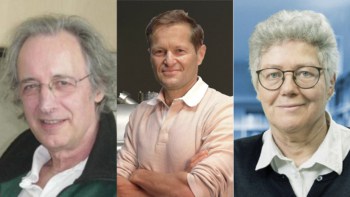
A device that uses sound waves to levitate, rotate and move objects in multiple directions has been developed by researchers in the UK and Spain. The “tractor beam” uses an array of miniature loudspeakers to create acoustic holograms that can manipulate objects in mid-air. Although they cannot propagate the vacuum in space to move spaceships and asteroids, sonic tractor beams could have a wide range of practical uses, such as moving delicate objects on a production line or transporting tiny drug capsules and microsurgical instruments through living tissue.
The work was inspired by research done by Mike MacDonald and colleagues last year, which showed that it is possible to pull an object with sound waves – the work featured in Physics World‘s top 2014 breakthroughs.
Bruce Drinkwater of the University of Bristol, who is one of the lead researchers in the current work, says that MacDonald and colleagues “did a really nice experiment showing you could get these attractive forces in acoustic systems. They had an array of loudspeakers, a bit like ours, and were able to apply a force to a specially shaped mass. We have gone from there and turned it into something that you could call a working stable tractor beam.”
Acoustic fields
Although acoustic levitation has been demonstrated before, it required particles to be enclosed by acoustic elements, while single-sided levitators have only managed to exert lateral or pulling forces, or required the use of an acoustic lens. The new device uses a grid of 64 off-the-shelf speakers (originally made for parking sensors) controlled by a programmable array of transducers. The transducer array – developed by Ultrahaptics, a spin-out company from the University of Bristol – creates haptic feedback in mid-air.
“When we realized we could use this equipment to create any acoustic field, we thought maybe we can create tractor beams,” says Drinkwater. The array creates acoustic shapes out of high-pressure ultrasound waves that can surround and trap objects. By carefully controlling the output of the speakers, the acoustic holograms can be adjusted to hold objects in mid-air and rotate and move them. The team created three different acoustic shapes – tweezers, a vortex that traps objects at its core, and a cage. Polystyrene particles ranging in diameter from 0.6 to 3.1 mm were controlled by the array, and it was strong enough to hold the spheres and counteract gravity from any direction.
Flexible devices
The tractor beam uses ultrasound at 40 kHz with a wavelength of about a centimetre. But Drinkwater plans to work on increasing the frequency and reducing the wavelength so that smaller particles can be manipulated. This could open up the possibility of using the technique for medical applications. An acoustic tractor beam could, for example, be used to move capsules into an exact location in the body and then blast them open to release drugs, or to manipulate tiny surgical instruments inside the body.
“This is a great paper, which shows a lot of acoustic-trapping techniques that are common in optical trapping but less so in acoustics,” says MacDonald. “As the paper says, all of the acoustic beams produced, and the manipulations achieved, could be done before, but usually with less flexible devices.” MacDonald told physicsworld.com that his original device was capable of producing all of the beams described in the new work, “but was made for focused ultrasound surgery. That means that although our device was already being used clinically, it was very expensive and less easily programmed.” He adds that the new approach is more flexible through the use of a programmable array.
The work is published in Nature Communications.



